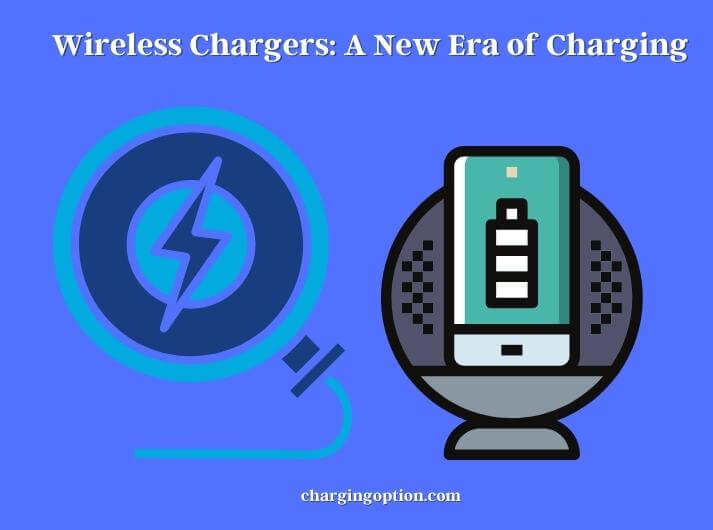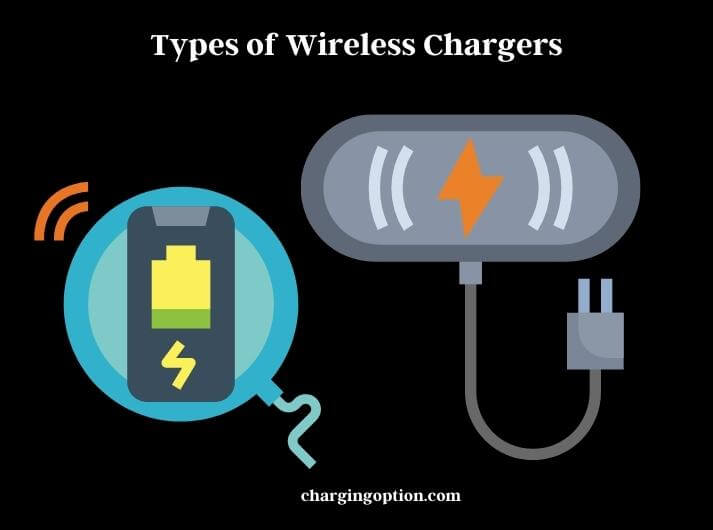Wireless chargers have revolutionized the way we charge our devices, making it easier and more convenient than ever before. With wireless charging technology, energy can be transmitted from a charging pad to a device without the need for cables or cords.
This has made it possible to charge devices on the go, at work, or even while traveling, without the need for a traditional charger or power source.

The benefits of wireless chargers are numerous. They offer a more streamlined charging experience, eliminating the need for cables and cords that can become tangled or damaged. They are also more convenient, allowing for charging without the need for a traditional power source.
Wireless chargers are often more aesthetically pleasing, with sleek and modern designs that can complement any home or office décor.
Wireless chargers have a relatively short history, but they have already become an essential part of our daily lives. As technology continues to advance, wireless charging technology is likely to become even more efficient and convenient, making it an even more attractive option for charging our devices.
Wireless Chargers
Wireless chargers are electronic devices that allow you to charge your compatible devices without the need for cables or wires. They use electromagnetic fields to transfer energy between two objects: the charger and the device being charged.
Wireless chargers typically consist of a charging pad or mat that you place your device on and a power source that plugs into an electrical outlet. When your device is placed on the pad, the charger creates an electromagnetic field that induces a current in a coil inside the device, which is then used to charge the device’s battery.
Wireless chargers are commonly used with smartphones, but they can also be used with other devices that support wireless charging, such as smartwatches and earbuds. They offer a convenient and clutter-free way to charge your devices, as there are no cables to manage or plugin.
The Invention of Wireless Chargers
The concept of wireless charging dates back to the late 19th century when physicist and inventor Nikola Tesla first proposed the idea of transferring power wirelessly. However, it wasn’t until the 21st century that the technology became commercially available.
The first wireless charger for consumer electronics was developed in 2008 by a company called Powermat. Their technology used magnetic induction to wirelessly charge devices placed on a special charging pad.
In 2010, the Wireless Power Consortium was formed to establish a standard for wireless charging technology called Qi (pronounced “chee”). This standard has since become widely adopted by manufacturers of smartphones, smartwatches, and other devices that support wireless charging.
Since then, there have been many advances in wireless charging technology, including the introduction of faster charging speeds and the ability to charge multiple devices on a single charging pad. Today, wireless chargers are widely available and used by millions of people around the world.
How do Wireless Chargers Work?
Wireless chargers work by using a technology called inductive charging. This technology uses electromagnetic fields to transfer energy from a charging pad to a device without the need for cables or cords. When the device is placed on the charging pad, the electromagnetic field generated by the pad induces a current in the device, which is then used to charge the device’s battery.

Inductive charging works by creating a magnetic field around the charging pad using a coil of wire. When the device is placed on the pad, it also contains a coil of wire that is designed to receive the energy from the magnetic field. The two coils are positioned close together, but not touching, allowing the energy to transfer from the pad to the device.
Magnetic resonance charging is another type of wireless charging technology that is similar to inductive charging but offers more flexibility in the positioning of the device on the charging pad. This technology uses resonant inductive coupling, which allows for energy transfer over a greater distance.
Radiofrequency charging is a newer technology that uses electromagnetic waves to transfer energy from the charging pad to the device. This technology is still in the early stages of development and is not yet widely available.
Wireless chargers offer a convenient and efficient way to charge devices without the need for cables or cords. As technology continues to advance, it is likely that wireless charging will become even more efficient and convenient, making it an even more attractive option for charging our devices.
Types of Wireless Chargers
There are several types of wireless chargers available on the market, each with its own unique features and capabilities.
Charging Pads
Charging pads are the most common type of wireless charger. They consist of a flat surface on which the device is placed for charging. Charging pads are available in a range of sizes, from small pads designed for single devices to larger pads that can charge multiple devices at once.

Charging Stands
Charging stands are similar to charging pads, but they allow the device to be propped up while it is charging. This is especially useful for devices that need to be used while they are charging, such as phones or tablets.
Charging Mats
Charging mats are larger than charging pads and are designed to charge multiple devices at once. They are commonly used in public places such as coffee shops and airports.
Car Chargers
Car chargers are designed to charge devices while on the go. They plug into the car’s cigarette lighter and provide a wireless charging pad for the device.
Portable Chargers
Portable chargers are battery-powered and allow devices to be charged without the need for a traditional power source. They are often used when traveling or in places where a power source is not readily available.
Furniture with Built-in Charging
Some furniture, such as tables and lamps, now comes with built-in wireless charging pads. This allows devices to be charged while they are being used, without the need for a separate charging pad or stand.
Compatibility with Devices
When choosing a wireless charger, it is important to consider compatibility with your devices. Not all devices are equipped with wireless charging capabilities, and even devices that are compatible with wireless charging may have different charging requirements.
The two main wireless charging standards are Qi and Powermat. Qi is the most widely used standard and is supported by many popular devices such as the iPhone, Samsung Galaxy, and Google Pixel. Powermat is less common and is used primarily by certain brands such as Duracell and select Starbucks locations.
If your device is not equipped with wireless charging capabilities, there are still options for adding this feature. Wireless charging cases and adapters can be purchased for devices that do not have built-in wireless charging. These cases and adapters are designed to fit specific devices and allow them to be charged wirelessly.
It is also important to consider the charging speed of the wireless charger. Some wireless chargers are designed for slower, more gradual charging, while others are capable of fast charging. Fast charging can be especially important for devices with large batteries or for those that require frequent charging.
Compatibility with devices is an important consideration when choosing a wireless charger. It is important to ensure that your device is compatible with the charging standard used by the charger and to choose a charger that provides the appropriate charging speed for your needs.
Factors to Consider when Choosing a Wireless Charger
When choosing a wireless charger, there are several factors to consider to ensure that you get the best charging experience possible. Here are some important factors to keep in mind:
Charging Speed
The charging speed of the wireless charger can vary depending on the device and the charger itself. Look for a charger that provides fast charging capabilities if you want to charge your device quickly.
Charging Standard
As mentioned earlier, there are two main wireless charging standards: Qi and Powermat. Make sure that the charger you choose is compatible with your device’s charging standard.
Size and Portability
Consider the size and portability of the wireless charger. If you plan to use it on the go, choose a charger that is compact and easy to carry.
Brand and Quality
The brand and quality of the wireless charger can affect its performance and durability. Look for a charger from a reputable brand and read reviews from other customers to ensure that you are getting a quality product.
Price
Wireless chargers come in a range of prices, so consider your budget when choosing a charger. Keep in mind that cheaper chargers may not offer the same charging speed or quality as more expensive options.
Additional Features
Some wireless chargers come with additional features such as LED lights, multiple charging ports (it is possible to replace the charging port on a Nintendo Switch), or built-in fans for cooling. Consider whether these additional features are important to you when choosing a charger.
Common Issues with Wireless Charging and How to Troubleshoot Them
While wireless charging can be a convenient way to charge your devices, there are some common issues that users may experience. Here are some common issues with wireless charging and how to troubleshoot them:
Device Not Charging
If your device is not charging when placed on the wireless charger, make sure that it is properly aligned with the charging pad. Some devices may require a specific position on the charging pad to charge properly.
Slow Charging
If your device is charging slowly, it may be due to a low-power charging pad or a non-fast charging device. Make sure that you are using a high-quality charging pad that is compatible with your device’s charging standard. You can also check if your device supports fast charging and use a fast charging pad if it does.
Overheating
Overheating can occur when the device is left on the charging pad for an extended period of time, especially when using a fast charging pad. If your device is overheating, remove it from the charging pad and allow it to cool down before continuing to use it.
Incompatible Device
If your device is not compatible with wireless charging, you can purchase a wireless charging case or adapter to add wireless charging capabilities. Make sure that the case or adapter is compatible with your device and charging standard.
Charging Interruptions
If your device is experiencing charging interruptions, it may be due to interference from other electronic devices. Try moving the charging pad to a different location or removing other electronic devices from the area.
Broken Charging Pad
If your wireless charging pad is not working, it may be due to a broken or damaged pad. Try using a different charging pad to see if the issue is with the pad or the device.
Troubleshooting issues with wireless charging can be relatively simple. By checking for alignment, compatibility, and charging speed, you can ensure that your device charges properly and efficiently. If you continue to experience issues with wireless charging, contact the manufacturer for assistance.
Final Verdict
Wireless charging has become increasingly popular as a convenient and efficient way to charge devices. With the ability to charge devices without the hassle of cables and wires, wireless charging offers a level of convenience that traditional charging methods cannot match.
When choosing a wireless charger, it is important to consider factors such as charging speed, compatibility with devices, and additional features. It is also important to be aware of common issues with wireless charging, such as slow charging and device compatibility, and how to troubleshoot them.
Wireless charging can be a great solution for charging your devices, but it is important to choose a charger that meets your specific needs and to be aware of potential issues.
